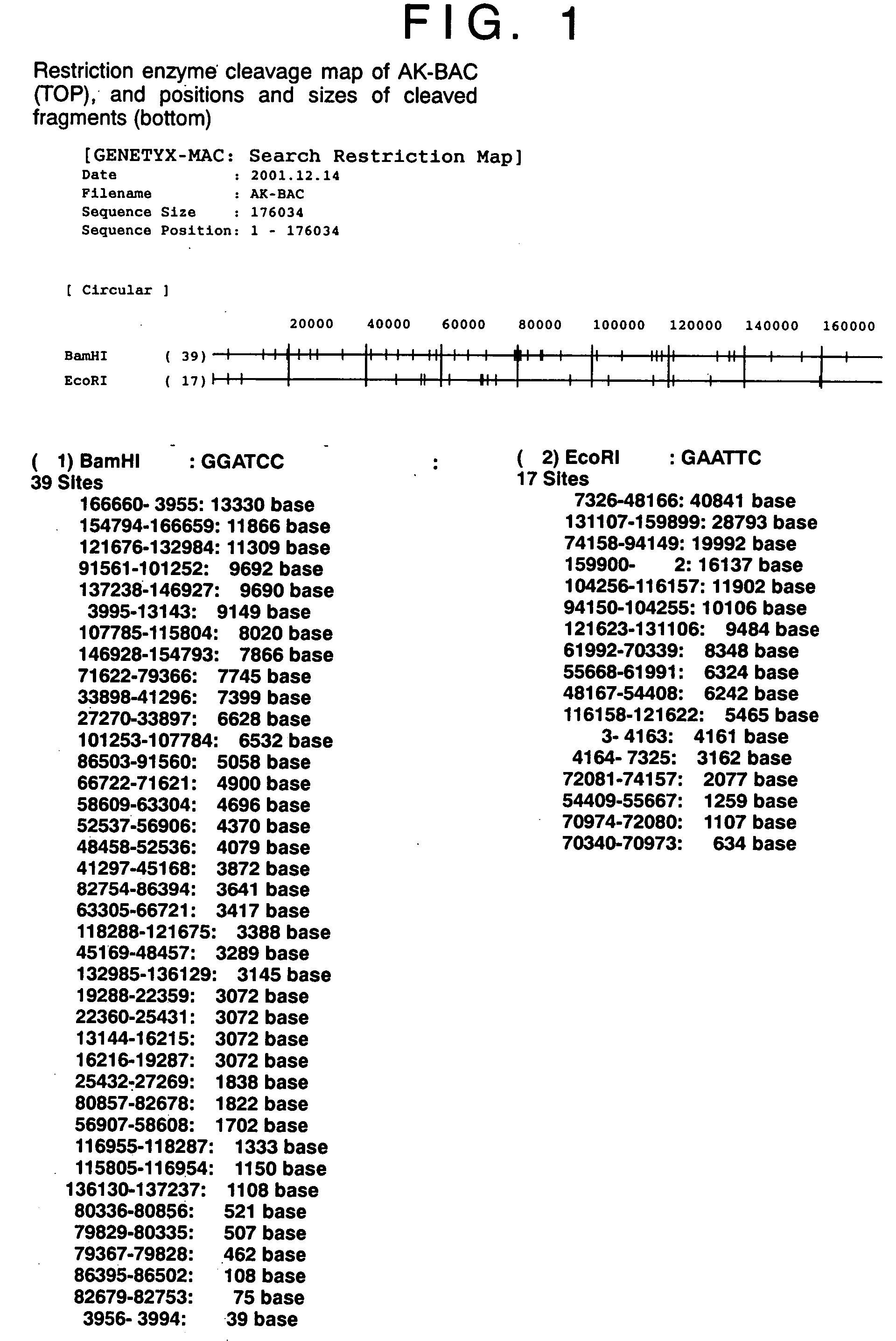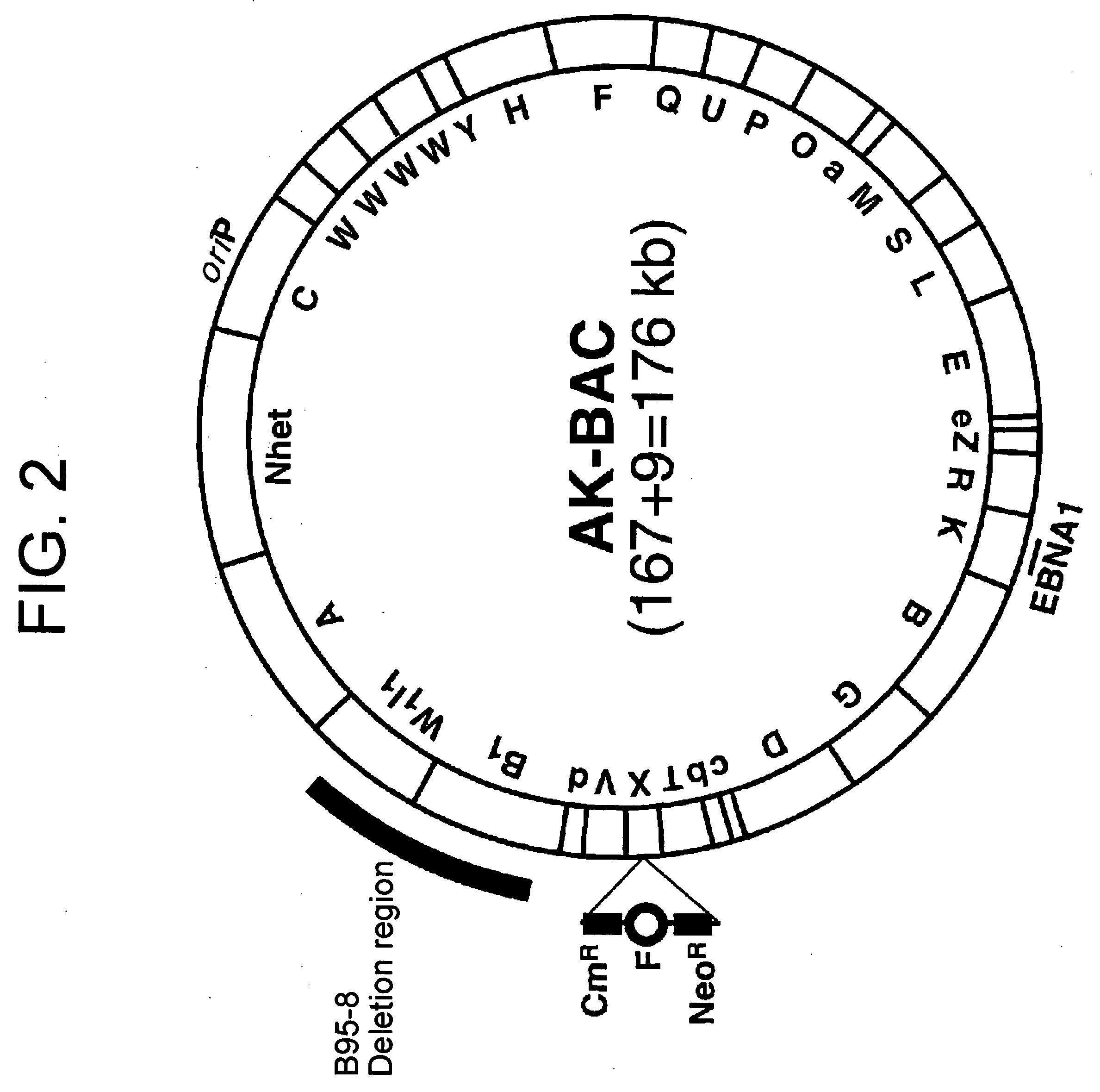Double-stranded cyclic dna capable of proliferating as a bacterial e coli chromosome
a technology of cyclic dna and chromosome, which is applied in the direction of dsdna viruses, viruses/bacteriophages, peptides, etc., can solve the problems of no cell line suitable for large-scale production of infectious viruses, time-consuming method, and inability to modify the genome, etc., to achieve convenient and large-scale production, easy modification, and rapid production of eb viruses
- Summary
- Abstract
- Description
- Claims
- Application Information
AI Technical Summary
Benefits of technology
Problems solved by technology
Method used
Image
Examples
example 1
[0041] In this Example, a BAC vector sequence was incorporated in a circular EB virus DNA in Akata cells.
[0042] A DNA fragment comprising BamHI-digested EB virus DNA fragments, T, X, and V was subcloned into an ordinarily-used cloning vector PUC119. A neomycin resistant gene (NeoR) and a BAC vector fragment derived from pBeloBAC11 vector (product of Genome Systems) were inserted into the BamHI-X fragment region. As illustrated in FIG.3, the BAC vector comprises OriS, repE, ParA, ParB and ParC, which enable the maintenance of the vector as a artificial chromosome (BAC), and a chloramphenicol resistant gene (CmR).
[0043] The resultant plasmid DNA was then cut into a linear piece by using a restriction enzyme HindIII, and 20 micrograms of the linear DNA was introduced into Akata cells having wild-type circular EB virus DNA (5×106 cells) by electroporation, followed by cultivation at 37° C. for 2 days under the conditions of 5% CO2 and saturated humidity. Two days later, the cells were...
example 2
[0049] This Example shows the possibility of rapid modification of an EB virus genome cloned into AK-BAC by using a highly-efficient homologous recombination method in Escherichia coli. In this Example, a gene of fluorescent protein “GFP” derived from luminous jellyfish was inserted into the region deleted in B95-8 strain (the region not necessary for virus production) of EB virus genome by homologous recombination. The method reported by Ioannou, et al. (Gene Therapy, 6, 442-447(1999)) was employed as a homologous recombination method.
[0050] A template consisting of an expression unit of the GFP gene (promoter+GFP gene+polyA signal) and a kanamycin resistant gene (KmR) working in Escherichia coli was PCR-amplified by using synthetic primers having sequences homologous to those of the region deleted in B95-8 strain of EB virus genome on their 5′ ends. The obtained PCR product was used as a targeting construct.
[0051] DH10B cells transformed by the AK-BAC obtained in Example 1 and t...
example 3
[0057] In this Example, Akata cells which have lost EB virus (EB virus-negative Akata cells) after long-term passage and subcultivation in culture medium containing 10% bovine fetal serum were used.
[0058] The DNA of AK-BAC-GFP obtained in Example 2 was introduced into the EB virus-negative Akata cells by electroporation. Two days later, the transfected cells were suspended in medium containing 700 μg / ml of neomycin. The suspension was seeded in 96-well plates. Half of the culture medium was replaced with fresh neomycin-containing culture medium every 5 days.
[0059] Numbers of neomycin-resistant cells obtained after three weeks of selection were analyzed by Southern blotting method, and cell clones harboring AK-BAC-GFP as circular DNAs (episomes) were selected.
[0060] The obtained cell clones were subjected to anti-immunoglobulin antibody treatment to induce virus production. Two days later, the culture supernatant was collected, and the amount of the obtained EB virus DNA and the v...
PUM
 Login to View More
Login to View More Abstract
Description
Claims
Application Information
 Login to View More
Login to View More - R&D
- Intellectual Property
- Life Sciences
- Materials
- Tech Scout
- Unparalleled Data Quality
- Higher Quality Content
- 60% Fewer Hallucinations
Browse by: Latest US Patents, China's latest patents, Technical Efficacy Thesaurus, Application Domain, Technology Topic, Popular Technical Reports.
© 2025 PatSnap. All rights reserved.Legal|Privacy policy|Modern Slavery Act Transparency Statement|Sitemap|About US| Contact US: help@patsnap.com



